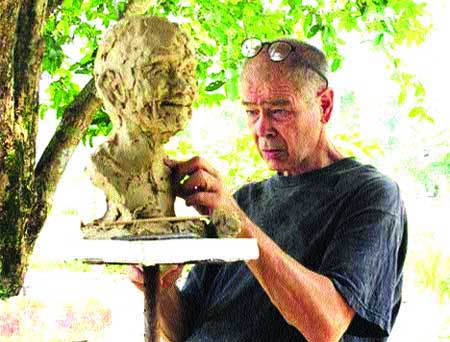US veteran sculpts the pain of VN past
Published: 18/05/2013 04:56
Former US soldier and artist Jim Gion first fell in love with Viet Nam when he was forced to serve here during the American War. Now, he is creating a statue of one of the war's most heroic participants, a brave mother who lost her husband and four sons in the struggle.
Over the past few weeks, a mysterious middle-aged foreigner has been a frequent visitor to Nguyen Thi Nhut's house in Quang Hien Village, Dien Ban District, Quang Nam Province. In 1969, greenhorn Gion, who was just 22 at that time, arrived in Viet Nam for the first time to participate in what he calls an "unjust war". Like many other US youths, he opposed the war and disliked using guns to kill people, but he was paradoxically driven to war in Viet Nam through...being "madly in love". Gion has also visited many famous trade villages in Viet Nam to learn from their experience. He is nurturing a dream that in the near future, he will open and run a sculpturing centre in the country that he loves. Vietnamnet |
Provide by Vietnam Travel
US veteran sculpts the pain of VN past - Social News | vietnam travel company
You can see more
- Belarusian Culture Days set for May 23-29 in Hanoi
- Plan for Dong Van geopark development approved
- Beginning first river bus route in Ho Chi Minh City in June
- Vietnam set to become a MICE ‘tiger’ of Southeast Asia
- Many students in Japan are in danger after snowslide
- Automated street parking piloted in Hanoi
- USAID supports Vietnam to fight wildlife smuggling
- Summer camp for overseas Vietnamese youth
enews & updates
Sign up to receive breaking news as well as receive other site updates!
- Hanoi ranked top 3 cuisine in the world in 2023
- Beautiful resorts for a weekend escape close to Hanoi
- Travel trends in 2023
- In the spring, Moc Chau is covered in plum blossoms.
- The Most Wonderful Destinations In Sapa
- Top 3 Special festivals in Vietnam during Tet holiday - 2023
- 5 tourist hotspots expected to see a spike in visitors during Lunar New Year 2023
- How To Make Kitchen Cleaned
- Health benefits of lime
- Cooperation expanding between Havard University and Vietnamese universities
-
vietnam travel
http://www.vietnamtourism.org.vn " Vietnam Tourism: Vietnam Travel Guide, Culture, Travel, Entertainment, Guide, News, and...
-
Vietnam culture, culture travel
http://travel.org.vn " Vietnam culture
-
Vietnam travel, vietnam travel news, vietnam in photos
http://www.nccorp.vn " Vietnam travel, vietnam travel news, vietnam in photos
-
Vietnam tourism
http://www.vietnamtourism.org.vn " The official online information on culture, travel, entertainment, and including facts, maps,...
-
Vietnam Travel and Tourism
http://www.vietnamtourism.org.vn/ " Vietnam Travel, Entertainment, People, Agents, Company, Vietnam Tourism information.
-
Information travel online
http://www.travellive.org "Information travel online













